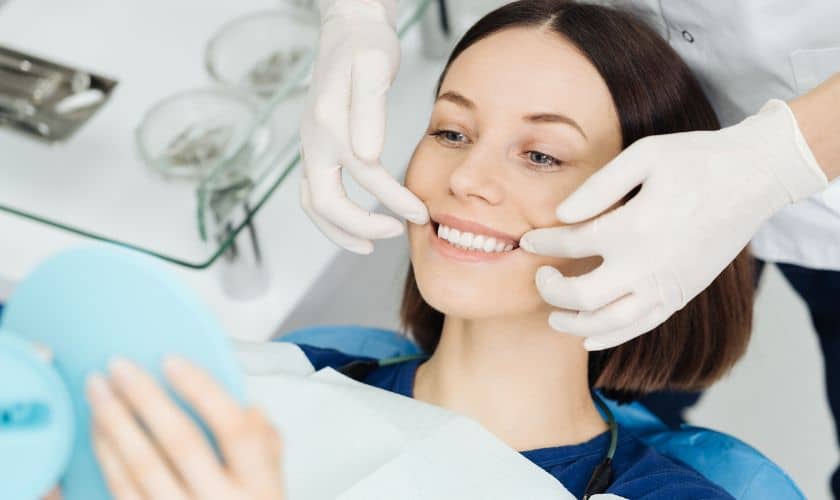If you’re someone who’s been struggling with orthodontic problems, then this is the perfect article for you. We know that having crooked or misaligned teeth can be frustrating and sometimes even painful. However, there are solutions out there that can help fix these issues once and for all. So sit back, relax, and let’s dive into the world of orthodontics together!
Teeth Crowding
Teeth crowding is a common orthodontic problem that occurs when there’s not enough space in the mouth for all of your teeth. This leads to overlapping and twisting which can make it difficult to clean your teeth properly, leading to an increased risk of gum disease and tooth decay.
Crowded teeth can also cause discomfort or even pain, especially during eating or speaking. Many people with crowded teeth may feel self-conscious about their appearance, which can lead to low self-esteem and confidence issues.
Luckily, there are several treatment options available for those who suffer from this condition. Braces remain one of the most effective ways of correcting overcrowding by gradually moving the teeth into their proper position over time.
Another option is Invisalign – clear aligners that work similarly to braces but are virtually invisible while being worn. This allows patients the freedom to continue with their daily lives without feeling embarrassed about having metal wires in their mouths.
Regardless of which method you choose, treating crowded teeth early on is important as it can prevent further complications down the line.
Overcorrecting Teeth
Overcorrecting teeth is a common orthodontic problem that occurs when too much pressure is applied to the teeth during treatment. This can result in teeth being pulled too far or rotated past their optimal position, causing discomfort and aesthetic issues.
One of the main causes of overcorrection is inexperienced orthodontists who are not familiar with proper tooth movement techniques. Additionally, patients who do not follow instructions for proper oral hygiene and care during treatment may also experience overcorrection.
The consequences of overcorrecting teeth can be severe, leading to long-term damage such as gum recession and root resorption. Therefore, it’s important for patients to seek experienced professionals who use modern technology like 3D imaging and Invisalign clear aligners to prevent this problem from occurring.
Overcorrecting teeth can cause significant problems if left untreated. Patients should carefully consider their options when choosing an orthodontist and ensure they receive personalized care tailored to their specific needs.
Crossbite
Crossbite is a common orthodontic issue that occurs when the upper and lower teeth don’t meet in the right position. This can result in various problems including jaw pain, difficulty chewing or speaking, and uneven wear on teeth.
There are two types of crossbites: anterior and posterior. Anterior crossbite occurs when the front teeth of the upper jaw overlap with those of the lower jaw. Posterior crossbite happens when some or all of the back teeth are not aligned properly.
Fortunately, there are several treatment options available for correcting a crossbite depending on its severity. The most common treatments include braces, clear aligners, retainers, palatal expanders or surgery.
It’s important to seek professional help if you suspect you have a crossbite as it can lead to additional dental problems such as gum disease and tooth decay. Remember that correcting your bite will not only improve your smile but also your overall oral health.
While having a crossbite may seem daunting at first glance there are plenty of effective ways to treat this condition which can positively impact both aesthetic appearance and functional ability alike.
Orthodontic Treatment Options
Orthodontic treatment options vary depending on the specific orthodontic problem. Here are some of the most common orthodontic treatments:
1. Braces: Braces are the most common orthodontic treatment option, especially for crowded or crooked teeth. They consist of brackets that are attached to the teeth and connected by wires.
2. Invisalign: Invisalign is a popular alternative to traditional braces that uses clear aligners to straighten teeth. These aligners can be removed when eating or brushing, making them more convenient than braces.
3. Retainers: After completing an orthodontic treatment, retainers may be recommended to help maintain the results achieved by braces or Invisalign.
4. Headgear: Headgear is sometimes used in conjunction with other orthodontic treatments as a way to correct bite problems.
5. Palatal Expanders: Palatal expanders widen upper jaws by gradually separating bones over time.
It’s important to consult with an experienced orthodontist who can evaluate your specific needs and recommend the best course of action for you or your child’s smile!
The Bottom Line
Orthodontic problems can occur to anyone at any age. It is important to identify these issues early on and seek professional help from an orthodontist. The good news is that modern treatments have made it easier than ever before to correct these problems.
Whether you suffer from teeth crowding, overcorrecting teeth, or a crossbite, there are numerous treatment options available today that can help you achieve the perfect smile. From traditional braces and aligners to advanced surgical procedures like jaw surgery, your orthodontist will work with you to determine the best course of action for your individual needs.
Remember, a straighter smile not only looks great but also promotes better oral health by making brushing and flossing more effective. So don’t hesitate – book an appointment with your local orthodontist today and take the first step towards achieving a healthier, happier smile!

